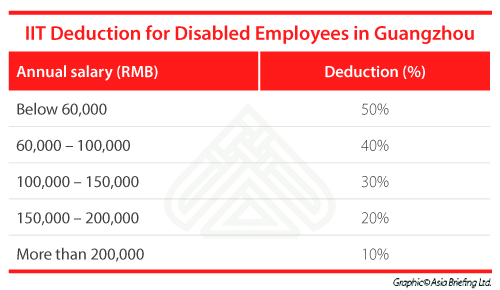The fallout from China’s abolishment of its one-child policy has taken new and unexpected turns in recent weeks including protests from parents with a disabled or severely ill child. The government plans to increase the monthly subsidy for families whose only child is disabled and unable to support the family as the parents age. The announcement—widely reported in Western media—has re-energized discussion of the role of the disabled in Chinese society, particularly the workforce.
When China hosted the Paralympic games in 2008, then-President Hu Jintao promised that the country would strive to make its disabled citizens “equal members of society,” which presaged a string of national and provincial policies aimed squarely at incentivizing businesses to hire disabled workers. Awareness of these incentives among foreign companies, however, has remained generally low since their implementation, and many domestic companies choose not to use them — two possible causes of the low employment rate of China’s disabled citizens.
The incentives
The preferential policies that exist for disabled workers in China mostly offer tax breaks or exemptions. However, the ease with which companies can qualify for these benefits varies, with eligibility often hinging on the size or the location of the company. Below, we take a closer look at the three main preferential policies.’


Corporate income tax
In China, companies can deduct a non-disabled employee’s annual salary from the profits taxed by CIT. For disabled employees, companies can deduct double their salary. If a disabled employee’s annual salary is RMB 100,000, for instance, then the company will be able to deduct RMB 200,000 from the CIT taxable amount.
In order to qualify for this benefit, companies must meet all of the following requirements:
- The disabled employee must have a minimum one-year labor contract or service agreement with the company;
- The company must pay the monthly social security costs for the disabled employee; and
- The disabled employee’s salary cannot be less than the lowest salary paid to a non-disabled employee.
Individual Income Tax
While any disabled person employed in China is eligible for IIT deduction, China’s tax authorities have yet to implement a nationwide standard. The deduction amount varies by region, with the country’s more affluent areas tending to provide greater deductions. Below, is an example in Guangzhou, Guangdong province.


VAT
The requirements to qualify for VAT exemption are extensive. At least 25 percent of a company’s workforce must be disabled and the company must have at least 10 disabled employees. In practice, this means that the exemption is only available to larger companies. If the workforce of a small startup with 16 staff were 50 percent disabled, for example, they would still be ineligible for the VAT exemption.
In addition, the conditions for qualifying for CIT exemption also apply for VAT exemption.
Quota for hiring disabled employees
The Chinese government set a minimum quota of disabled employees that a company must hire. The national average is 1.5 percent of a firm’s workforce, but the rate can differ by province. The quota does not apply to companies under three years old and with a workforce of less than 20.
Companies that don’t meet this quota have to pay into a fund called the Baozhang Jin. The fee varies according to location, but the majority of companies choose to pay into the fund rather than employ the requisite number of disabled workers. Reluctance to train disabled staff and integrate them into the company structure is a commonly cited reason for this, but the fact that few companies choose to take advantage of the Baozhang Jin’s exemption is one of the root causes of China’s low disabled employment rate.
Defining ‘disability’
The Law on the Protection of Disabled Persons is China’s primary piece of legislation on disability rights. It defines a disabled person as someone who “suffers from abnormalities or loss of a certain organ or function, psychologically or physiologically, or in anatomical structure and has lost wholly or in part the ability to perform an activity in the way considered normal.” The law further states that the term “disabled person” refers to those with “visual, hearing, speech or physical disabilities, mental retardation, mental disorder, multiple disabilities and/or other disabilities.” Importantly, it notes that the “criteria for classification of disabilities shall be established by the State Council”.
Looking ahead
The incentive framework that China has created for hiring disabled employees has been incremental since Hu Jintao’s speech at the Paralympic games. Policies such as the Baozhang Jin have been revised and implemented as recently as October 2015, and China is still catching up with some of its international commitments regarding disabled employment, such as those in the International Labor Organization’s conventions on employment and education for the disabled that China ratified in 1985.
This suggests that more change can be expected in both the short and long term, with China developing a policy framework that supports its public and international backing for disabled employment and further incentivizes China-based businesses to hire disabled workers.
This article was first published on China Briefing. Since its establishment in 1992, Dezan Shira & Associates has been guiding foreign clients through Asia’s complex regulatory environment and assisting them with all aspects of legal, accounting, tax, internal control, HR, payroll and audit matters. As a full-service consultancy with operational offices across China, Hong Kong, India and emerging ASEAN, we are your reliable partner for business expansion in this region and beyond.For inquiries, please email us at [email protected].





























